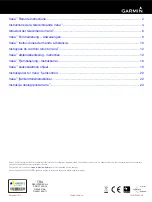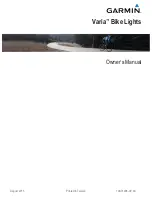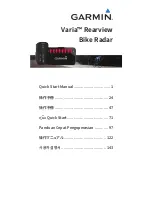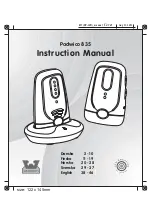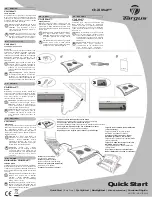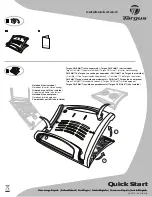
st
eut
e Schaltger
ät
e GmbH & Co. K
G,
Brück
ens
tr
aße 91, 32584 Löhne, Germany
, www
.s
teut
e.c
om
//
HS Si 4 Extreme
Montage- und Anschlussanleitung / Sicherheitssensor
Mounting and wiring instructions / Safety sensor
Instructions de montage et de câblage / Capteur de sécurité
Istruzioni di montaggio e collegamento / Sensore di sicurezza
Instruções de montagem e instalação / Sensor de segurança
Инструкция по монтажу и подключению / Датчик безопасности
English
spare actuators because of the danger of manipulation is prevented. In
addition, the actuator must be positioned or protected in such a way
that damage by predictable external influence is avoided. Please en-
sure that, even in case of failure, the safety sensor cannot be moved
from its position.
When mounting actuator and sensor please observe
the requirements of EN ISO 14119, especially paragraph 7, »Design to
decrease manipulation and bypass of interlocking devices.«!
For pro-
tection against unauthorized manipulation, use e.g. one way safety
screws, Torx with pin, riveting, etc. In contrast to magnetic safety sen-
sors with reed contacts, the HS Si 4 can also be mounted on ferro-
magnetic material without relevant change in switching distances. Do
not install the safety sensor and the actuator in strong magnetic fields.
The presence of ferromagnetic chips may reduce sensitivity. Protected
wiring by cable conduit, armoured conduit or similar measures is re-
quired for the variants HS Si 4 2Ö in order to avoid faults by short-cir-
cuiting. With the variants HS Si 4 1Ö/1S, monitoring of the antivalence
is required. Please also observe the instructions in the standards EN
ISO 12100 or EN ISO 14120.
Notices
The specified switching distances refer to face-to-face mounted safety
sensors and actuators. Different arrangements are possible, may lead
to different switching distances, however. The maximum possible off-
set between actuator and sensor can be found in the diagram »Axial
offset«. It must be observed that protective guards like doors, grids,
etc. change their position / direction in due time because of mechani-
cal wear. The correct function should be verified by the connected
safety monitoring module. After wiring, a functional test must be car-
ried out by opening and closing the protective guard. Closing of the
protective guard must not lead to an automatic start of a dangerous
machine function. This may only be initiated by a start command. The
connected safety module also defines the maximum switching fre-
quency of the sensor. Do not use the sensor as mechanical end-stop.
Any mounting position is possible. Reconstruction and alterations at
the sensor are not allowed. For the integration of the switch into the
entire system, the control category determined in the risk assessment
must be strictly observed and respected. Therefore, a validation ac-
cording to DIN EN ISO 13849-2 or DIN EN 62061.
Furthermore, the
Performance Level according to DIN EN ISO 13849-1 and SIL CL Level
according to DIN EN 62061 can be lower than the single level because
of the combination of several safety components and other safety-re-
lated devices, e.g. by serial connection of sensors.
The responsibility
taken by the manufacturer of a plant or machine implies to secure the
correct general function. Subject to technical modifications. Moreover,
steute does not assume any liability for recommendations made or im-
plied by this description. From this description new claims for guaran-
tee, warranty or liability cannot be derived beyond the general terms
and conditions of delivery.
Maintenance
With careful mounting as described above, only minor maintenance is
necessary. We recommend a routine maintenance as follows:
1. Check for the switching function.
2. Check for tight installation of the actuator and the switch.
Destination et emploi
Le capteur de sécurité HS Si 4 Extreme est prévu pour l’utilisation
dans les circuits de sécurité et destiné à la surveillance de protecteurs
mobiles selon EN ISO 14119 (EN 1088) type de construction 4. Seul le
système complet: capteur de sécurité / actionneur / module de sécuri-
té, permet de remplir les exigences de la fonction de sécurité.
Montage / Raccordement
Fixer le capteur de sécurité et l'actionneur sur une surface plane et
selon les marquages qui se trouvent à l'opposé. Seuls des électriciens
compétents peuvent effectuer le raccordement électrique. Lors du
montage, prévoir un positionnement mécanique approprié de manière
à empêcher toute possibilité de fraude par un autre actionneur ou ac-
tionneur de rechange. En outre, l'actionneur doit être disposé, ou pro-
tégé de manière à éviter d'éventuelles dégradations pouvant être cau-
sées par des influences externes prévisibles. Tout déplacement du
capteur de sécurité, même en cas de défaillance, doit être empêché.
Pour le montage de l'actionneur et du capteur, les exigences selon EN
ISO 14119 sont à respecter, en particulier le point 7, »Construction
pour réduire les possibilités de contournement des dispositifs de ver-
rouillage«!
Fixer l'actionneur pour éviter un desserrage non autorisé,
par ex. avec des vis de sécurité indémontables, Torx avec goupille, ri-
vetage etc.
Contrairement aux capteurs de sécurité magnétiques à
contact Reed, le HS Si 4 peut également être monté sur un matériau
ferromagnétique sans modification significative des distances de com-
mutation. Monter le capteur de sécurité et l'actionneur à l'abri de
champs magnétiques puissants. Les copeaux de fer doivent être te-
nues à l'écart. Pour les variantes HS Si 4 2Ö, une installation protégée
par un conduit de câble, un tube blindé ou équivalents est nécessaire
pour exclure les erreurs causées par des courts circuits sur une ligne.
Pour les variantes HS Si 4 1Ö/1S une surveillance de l’antivalence est
nécessaire. Les recommandations des normes EN ISO 12100 et EN
ISO 14120 doivent être respectées.
Français
3. Remove of dirt.
4. Check enclosure for damage.
Behaviour in case of failure
No enabling signal indicated with closed protective guard. This can be
triggered by the following:
- Alignment of sensor and actuator not correct
- Safe switch-off distance not reached
- Interference by strong external magnetic fields
- Too high switching frequency
- Maximum life time of sensor has expired
Cleaning
- In case of damp cleaning: use water or mild, non-scratching, non-
chafing cleaners.
- Do not use aggressive cleaners or solvents.
Disposal
- Observe national, local and legal regulations concerning disposal.
- Recycle each material separately.


















